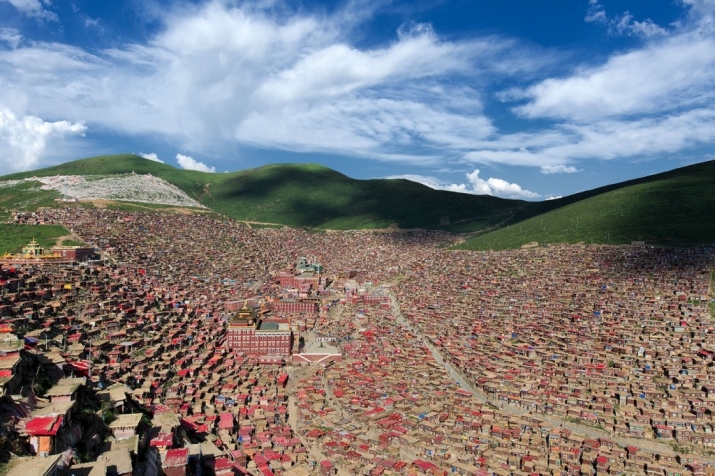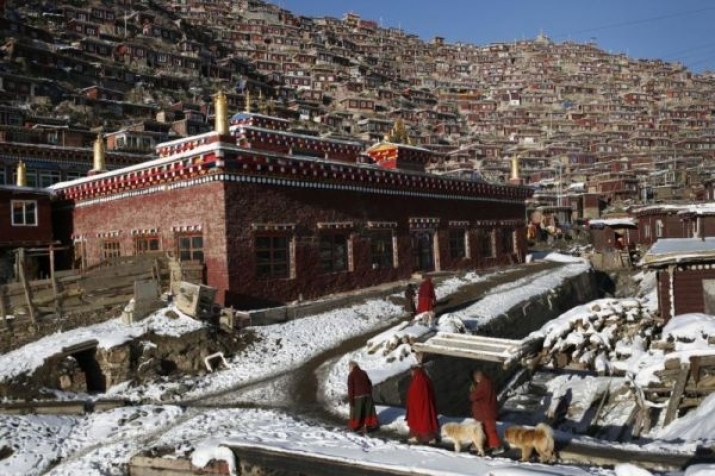NEWS
China Official Says Rebuilding Underway at Larung Gar, 800 Resettled
 In June last year, Sertar County officials issued an order stating that by October 2017 only 1,500 monks and 3,500 nuns would be allowed to live at Larung Gar. From placeaholic.com
In June last year, Sertar County officials issued an order stating that by October 2017 only 1,500 monks and 3,500 nuns would be allowed to live at Larung Gar. From placeaholic.comA government spokesman for Sertar County in China’s southwestern Sichuan Province on Tuesday denied media reports that Larung Gar Buddhist Academy, believed to be the largest center of Buddhist learning in the world, is being demolished by state workers. The official asserted that reconstruction work is underway to improve safety and public health at the sprawling monastic complex.
“The purpose of the renovation is to improve the living standard of the residents there and eliminate fire hazards,” said county government spokesman Jiang Zhiming, adding that the work had begun in May last year and would be completed this month. The official is reported as saying that only some buildings had been demolished to allow access for firefighters. (The Globe and Mail)
In June last year, the government of Sertar County issued an order stating that by October 2017 only 1,500 monks and 3,500 nuns would be allowed to live at the monastic college. The order follows similar moves in 2001, when the authorities organized a mass eviction of residents from the institute, and in late 2015, when further expulsions were accompanied by an order to reduce admissions to curb the rapid growth of the monastic population. The latest order did not give a reason for the decision, but cited two central government meetings during which Chinese President Xi Jinping had stressed “national unity” and the necessity for religious groups to support the Communist Party and “merge their religious doctrines with Chinese culture.” (Los Angeles Times)
Larung Gar Buddhist Academy sits at an elevation of roughly 4,000 meters, some 14 kilometers from the town of Sertar. The nearest large city is Chengdu, about 640 kilometers away. The institute was founded in 1980 by the respected teacher Khenpo Jigme Phuntsok (1933–2004), a lama of the Nyingma school of Vajrayana Buddhism. Built in what was then an uninhabited valley, the institute grew to become perhaps the largest and most important center of Buddhist learning in the world. Khenpo Jigme Phuntsok, himself from Sertar, was born to a family of nomads, and at the age of two was identified as the reincarnation of Tertön Sogyal Lerab Lingpa (1856–1926). He was known for keeping a strict focus on Buddhism rather than politics at the institute.
Before the latest move to limit the monastic population, an estimated 10,000 monks, nuns, and lay students lived in small wooden cabins on the hillsides surrounding the monastery complex, although some estimates put the number as high as 40,000. Although Tuesday’s statement from the government spokesman did not detail the present population of the Buddhist academy, Jiang said about 800 monastics had been resettled in a nearby town.
The China Daily newspaper reported on Tuesday that Larung Gar had grown “haphazardly” over the years “without regard to geological risks” in the seismically active area. The report said the site had become vulnerable to security, hygiene, and infectious disease risks, noting that a fire in 2014 had destroyed some 150 cabins, although there were no casualties at the time. (ChinaDaily.com.cn)
 Tibetan nuns walk by houses and monastery buildings at Larung Gar in 2009. From newsday.com
Tibetan nuns walk by houses and monastery buildings at Larung Gar in 2009. From newsday.comThe site of Larung Gar was chosen by Khenpo Jigme Phuntsok because of its historical connection to the Vajrayana tradition. It is said that His Holiness the first Dudjom Rinpoche, Dudjom Lingpa (1835–1904) stayed here with his 13 disciples. The academy was conceived as an independent center of study that would help revitalize the Dharma and revive the study and practice of Tibetan Buddhism following China’s Cultural Revolution (1966–76), during which Tibetan Buddhism was suppressed and thousands of monasteries were destroyed. The institute has become renowned for the quality of both its religious and secular education. English, Chinese, and Tibetan languages and modern computer studies are taught alongside a traditional non-sectarian Buddhist curriculum. About 500 khenpos—holders of doctoral degrees in divinity—have studied at Larung Gar Buddhist Academy.
See more
China says rebuilding major western Buddhist learning centre (The Globe and Mail)
Buildings redone at Buddhist academy (ChinaDaily.com.cn)
For 2nd time in 15 years, Tibetan Buddhist academy in China faces demolition order (Los Angeles Times)
Related news from Buddhistdoor Global
Demolition Work at Larung Gar Halted as Winter Closes In
State Authorities Cancel Annual Buddhist Ceremony at Larung Gar Institute
Government Workers Begin Demolishing Buildings at Larung Gar Buddhist Academy
Chinese Authorities Plan Major Reduction of Monastic Population at Larung Gar
Larung Gar Nuns Push for Gender Equality in Tibetan Buddhism
Chinese Government Orders Larung Gar Buddhist Institute to Reduce Admissions
Related features from Buddhistdoor Global
The Wonders of Kham and Larung Gar
The Wonders of Kham and Larung Gar, Part Two














